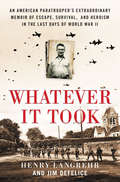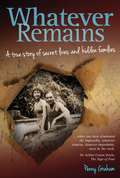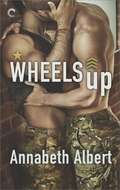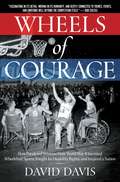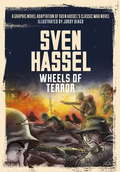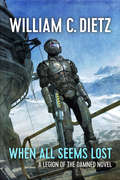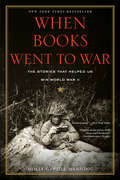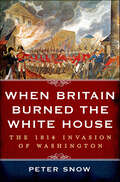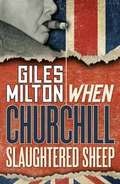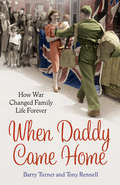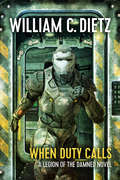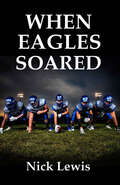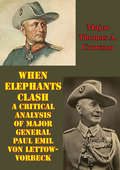- Table View
- List View
Whatever It Takes
by Dixie Lee BrownAll three parts in one volume!Fans of Cindy Gerard and Jaci Burton will love the next thrilling novel in Dixie Lee Brown's suspenseful Trust No One series...Assassin Alex Morgan will do anything to save an innocent life--especially if it means rescuing a child from a hell like the one she endured.But going undercover as husband and wife, with none other than the disarmingly sexy Detective Nate Sanders, may be a little more togetherness than she can handle. She's used to working alone, and no man is going to change that--not even a man who makes her heart pound and her defenses crumble with just a touchNate has dodged more than a few bullets over the years, but fighting his attraction for Alex may be the bullet that does him in. Still, Nate's determined to help her find the missing kid. There's no doubt in his mind that they're walking straight into danger, but Nate's willing to face anything if it means protecting Alex. She might have been on her own once, but Nate has one more mission: to stay by her side--forever.
Whatever It Takes: Part Three
by Dixie Lee BrownThe third and final installment in Dixie Lee Brown's thrilling novel Whatever It Takes!Want to dip into the story before you decide? Start reading Parts One & Two of Three now (Chapters 1--15). It is not the whole book.Love what you've read? You can buy Part Three (Chapters 16--22) or the full-length book on August 12, 2014.Fans of Cindy Gerard and Jaci Burton will love the next thrilling novel in Dixie Lee Brown's suspenseful Trust No One series ... Assassin Alex Morgan will do anything to save an innocent life--especially if it means rescuing a child from a hell like the one she endured.But going undercover as husband and wife, with none other than the disarmingly sexy Detective Nate Sanders, may be a little more togetherness than she can handle. She's used to working alone, and no man is going to change that--not even a man who makes her heart pound and her defenses crumble with just a touch.Nate has dodged more than a few bullets over the years, but fighting his attraction to Alex may be the bullet that does him in. Still, he's determined to help her find the missing kid. There's no doubt in his mind that they're walking straight into danger, but Nate's willing to face anything if it means protecting Alex. She may have been on her own once, but Nate has one more mission: to stay by her side--forever.
Whatever It Took: An American Paratrooper's Extraordinary Memoir of Escape, Survival, and Heroism in the Last Days of World War II
by Jim DeFelice Henry LangrehrPublished to mark the 75th anniversary of VE Day, an unforgettable never-before-told first-person account of World War II: the true story of an American paratrooper who survived D-Day, was captured and imprisoned in a Nazi work camp, and made a daring escape to freedom. Now at 95, one of the few living members of the Greatest Generation shares his experiences at last in one of the most remarkable World War II stories ever told. As the Allied Invasion of Normandy launched in the pre-dawn hours of June 6, 1944, Henry Langrehr, an American paratrooper with the 82nd Airborne, was among the thousands of Allies who parachuted into occupied France. Surviving heavy anti-aircraft fire, he crashed through the glass roof of a greenhouse in Sainte-Mère-Église. While many of the soldiers in his unit died, Henry and other surviving troops valiantly battled enemy tanks to a standstill. Then, on June 29th, Henry was captured by the Nazis. The next phase of his incredible journey was beginning.Kept for a week in the outer ring of a death camp, Henry witnessed the Nazis’ unspeakable brutality—the so-called Final Solution, with people marched to their deaths, their bodies discarded like cords of wood. Transported to a work camp, he endured horrors of his own when he was forced to live in unbelievable squalor and labor in a coal mine with other POWs. Knowing they would be worked to death, he and a friend made a desperate escape. When a German soldier cornered them in a barn, the friend was fatally shot; Henry struggled with the soldier, killing him and taking his gun. Perilously traveling westward toward Allied controlled land on foot, Henry faced the great ethical and moral dilemmas of war firsthand, needing to do whatever it took to survive. Finally, after two weeks behind enemy lines, he found an American unit and was rescued.Awaiting him at home was Arlene, who, like millions of other American women, went to work in factories and offices to build the armaments Henry and the Allies needed for victory. Whatever It Took is her story, too, bringing to life the hopes and fears of those on the homefront awaiting their loved ones to return.A tale of heroism, hope, and survival featuring 30 photographs, Whatever It Took is a timely reminder of the human cost of freedom and a tribute to unbreakable human courage and spirit in the darkest of times.
Whatever Remains: A True Story of Secret Lives and Hidden Families
by Penny F. GrahamWhatever Remains is a true story. The fall of Singapore is considered one of Britain’s worst defeats of the Second World War. For Penny Graham’s father, however, it became a life-changing opportunity to shed once and for all, all of the shackles of a family he no longer wanted. From 1942 onwards her parents would carry passports that gave them backgrounds that had nothing to do with reality. In 2010, a recognised Australian author claimed that her father and mother were involved in espionage for the British Government before, during and after World War 2. Although he worked in Australian naval intelligence during the war, there is no evidence whatsoever that he was an MI6 spy. He clearly had his own motives for the change of identity but they had nothing to do with espionage. Penny Graham spent most of her adult life unravelling the truth about her family history. Her journey took her around the world twice, on many twists and turns, false leads and dead ends as she discovers hew her father managed to hoodwink so many people in his long and complex life. Whatever Remains is a beautifully written story about solving mysteries, conquering adversity and ultimately finding where you belong in the world. It’s a slice of history worth telling.
Wheat and not weeds: Honor To A Marshal
by G. G. Vega Vanessa TorreMy country, the Republic of Paraguay, a nation that was born big, was strong, independent and prosperous, which aroused the envy of neighboring nations, which allied themselves to make war. Three nations, who promised to sweep my country in three months, but the intention came to them, it took them 5 long and hard years. But it was my country, my race that paid the price, there were only human remains, malnourished and sick women, children in extreme conditions, and a few men. God did not want Paraguay to become extinct, despite the terrifying genocide that had suffered and had been hidden in history. This book reminds you that Paraguay is Wheat and not weeds. We fought two wars but for noble reasons, not because of envy, evil or criminal ambition.
Wheels Up: Wheels Up Tight Quarters Squared Away (Out Of Uniform Ser. #4)
by Annabeth AlbertTheir love is forbidden, but their hearts aren’t listening to rules and regulations…Lieutenant Dustin Strauss is a reformed man. No longer a twentysomething hell-raiser, he’s his SEAL team’s new XO—and a man with a secret. Or seven. He’s kept his bisexual identity under wraps for years, along with his kinky side and a fondness for the military-themed semianonymous hookup website Joe4Joe. His latest chat buddy is more than a sexy online distraction—they’re taking their very not-safe-for-work relationship into real time.Petty Officer Wes Lowe has a smart mouth, a take-charge attitude and an uncanny ability for making things go boom. The life of an enlisted man isn’t always enough to satisfy him, but one wild, no-questions-asked weekend with his online love comes close. When a transfer order comes in, Wes feels ready and centered. He’ll make a good impression on his new SEAL team and keep his growing feelings for Dustin on the down low.But as they log more time online and some very real emotions surface, Dustin and Wes struggle to pretend they’re just a harmless fling. And when his commander introduces Dustin to his team’s newest member, they’re in for the shock of a lifetime…and a crushing disappointment: their difference in ranks means even a friendship without sexual contact could end their navy careers for good. With their hearts on the line, Dustin and Wes may not survive their next mission, let alone find a way toward a future together.This book is approximately 77,000 wordsOne-click with confidence. This title is part of the Carina Press Romance Promise: all the romance you’re looking for with an HEA/HFN. It’s a promise!
Wheels of Courage: How Paralyzed Veterans from World War II Invented Wheelchair Sports, Fought for Disability Rights, and Inspired a Nation
by David DavisOut of the carnage of World War II comes an unforgettable tale about defying the odds and finding hope in the most harrowing of circumstances. Wheels of Courage tells the stirring story of the soldiers, sailors, and marines who were paralyzed on the battlefield during World War II-at the Battle of the Bulge, on the island of Okinawa, inside Japanese POW camps-only to return to a world unused to dealing with their traumatic injuries. Doctors considered paraplegics to be "dead-enders" and "no-hopers," with the life expectancy of about a year. Societal stigma was so ingrained that playing sports was considered out-of-bounds for so-called "crippled bodies." But servicemen like Johnny Winterholler, a standout athlete from Wyoming before he was captured on Corregidor, and Stan Den Adel, shot in the back just days before the peace treaty ending the war was signed, refused to waste away in their hospital beds. Thanks to medical advances and the dedication of innovative physicians and rehabilitation coaches, they asserted their right to a life without limitations. The paralyzed veterans formed the first wheelchair basketball teams, and soon the Rolling Devils, the Flying Wheels, and the Gizz Kids were barnstorming the nation and filling arenas with cheering, incredulous fans. The wounded-warriors-turned-playmakers were joined by their British counterparts, led by the indomitable Dr. Ludwig Guttmann. Together, they triggered the birth of the Paralympic Games and opened the gymnasium doors to those with other disabilities, including survivors of the polio epidemic in the 1950s. Much as Jackie Robinson's breakthrough into the major leagues served as an opening salvo in the civil rights movement, these athletes helped jump-start a global movement about human adaptability. Their unlikely heroics on the court showed the world that it is ability, not disability, that matters most. Off the court, their push for equal rights led to dramatic changes in how civilized societies treat individuals with disabilities: from kneeling buses and curb cutouts to the Americans with Disabilities Act of 1990. Their saga is yet another lasting legacy of the Greatest Generation, one that has been long overlooked. Drawing on the veterans' own words, stories, and memories about this pioneering era, David Davis has crafted a narrative of survival, resilience, and triumph for sports fans and athletes, history buffs and military veterans, and people with and without disabilities.
Wheels of Terror
by Sven HasselSven Hassel's ultimate tank warfare novel.'This is a book of horrors, and should be left alone by those prone to nightmares. Sven Hassel's descriptions of the atrocities committed by both sides are the most horrible indictments of war I have ever read ... A great war novel!' Alan SilitoeStationed on the Russian Front and now equipped with armoured vehicles, Sven Hassel and his comrades from the 27th Penal Regiment fight on remorselessly...All of them should be dead: life expectancy on the Russian Front is measured in weeks. But Sven, Porta, Tiny and The Legionnaire fight to the end, not for Germany, not for Hitler, but for survival. WHEELS OF TERROR is a sobering depiction of war's brutalities, and the violence and inhumanity that the history books leave out.
Wheels of Terror (Sven Hassel War Classics)
by Sven HasselThis is a book of horrors, and should be left alone by those prone to nightmares. Sven Hassel's descriptions of the atrocities committed by both sides are the most horrible indictments of war I have ever read ... A great war novel!' Alan SilitoeStationed on the Russian Front and now equipped with armoured vehicles, Sven Hassel and his comrades from the 27th Penal Regiment fight on remorselessly...All of them should be dead: life expectancy on the Russian Front is measured in weeks. But Sven, Porta, Tiny and The Legionnaire fight to the end, not for Germany, not for Hitler, but for survival. WHEELS OF TERROR is a sobering depiction of war's brutalities, and the violence and inhumanity that the history books leave out.Read by Rupert Degas(p) 2014 Orion Publishing Group
Wheels of Terror: The Graphic Novel
by Sven Hassel Jordy DiagoA graphic novel adaptation of Sven Hassel's classic war novel, WHEELS OF TERROR, illustrated by Jordy Diago.Stationed on the Eastern Front and now equipped with armoured vehicles, Sven Hassel and his comrades from the 27th Penal Regiment fight on remorselessly . . . All of them should be dead: life expectancy on the Front is measured in weeks. But Sven, Porta, the Old Un and the Legionnaire fight to the end, not for Germany, not for Hitler, but for survival.From the blistering cold to the horrors of tank warfare, WHEELS OF TERROR is a sobering depiction of war's brutalities, and the violence and inhumanity that the history books leave out.
When All Else Fails
by Rayyan Al-ShawafA darkly humorous saga set in post-9/11 America and the Middle East When All Else Fails begins on September 12th, 2001. It is the story of Hunayn, a luckless and lovelorn Iraqi college student living in Orlando, Florida, after having graduated from high school in Beirut. Hunayn&’s life is upended by 9/11—but not immediately, and not in the way that he, fearful in the aftermath of the attacks, initially expects. As America settles into its post-9/11, open-ended &“Septemberland&” phase (vigilant but also overly suspicious and even paranoid), many Arab and Muslim Americans are made to feel it&’s no longer their home. With Hunayn, who muddles through a series of surreal episodes in Orlando and nearby Indiantown, the situation proves almost the opposite: Septemberland—so many of whose citizens think they have Hunayn figured out just because of his name or origins—comes to remind him of his most recent unhappy home, Lebanon, which he assumed he&’d left behind. Now, having had his fill of disconcerting experiences, Hunayn returns to Beirut. At least he knows how to navigate life back there—or so he thinks. It turns out that Lebanon is about to undergo political upheaval of its own: a former prime minister opposed to neighboring Syria&’s control of the country is assassinated; subsequent popular protests compel the Syrian regime to withdraw its army; a spate of mysterious bombings terrorizes everyone; and Israel, another neighbor, launches a war on Lebanon in retaliation for an attack by a Lebanese militant group. Hunayn finds himself aswirl in the maelstrom. And all the while, he watches from afar as Iraq, his fabled homeland and the owner of his heart, unravels in the wake of the US-led invasion.
When All Seems Lost: A Novel Of The Legion Of The Damned (Legion of the Damned #7)
by William C. DietzThe New York Times bestselling author of Battle Hymn continues his Legion of the Damned™ sci-fi military series with an “…adrenaline-fueled Clancy-esque adventure” that “…is Dietz in top form.”—Publishers WeeklyThe war against the seemingly unstoppable Ramanthian menace is faltering, with Confederacy forces under relentless attack. Desperate for allies, President Nankool—accompanied by his advisors and diplomat Christine Vanderveen—is headed for a summit that could secure some much needed support from the Alpha Clones when his fleet is ambushed.Vanderveen, Nankool, and the few other survivors are taken prisoner, though their identities remain thankfully unknown. Condemned to a labor camp on a remote planet, the loyal Vanderveen must not only deal with her vicious captors, but with those who might be willing to betray their government and President Nankool. But soon none of that will matter—since the planet is about to be overrun by billions of Ramanthian hatchlings, all eager to feed on human flesh.Their only hope lies in the hands of Vanderveen’s one-time lover Captain Antonio Santana, and the Legion’s cybernetically-enhanced warriors, who are about to launch an impossible rescue mission that will decide not only the fate of the captives, but that of the civilized galaxy.
When America Turned: Reckoning with 1968
by David WyattMuch has been written about the seismic shifts in American culture and politics during the 1960s. Yet for all the analysis of that turbulent era, its legacy remains unclear. In this elegantly written book, David Wyatt offers a fresh perspective on the decade by focusing on the pivotal year of 1968. He takes as his point of departure the testimony delivered by returning veteran John Kerry before the Senate Armed Services Committee in 1971, as he imagined a time in the future when the word "Vietnam" would mean "the place where America finally turned." But turning from what, to what--and for better or for worse? Wyatt explores these questions as he retraces the decisive moments of 1968--the Tet Offensive, the McCarthy campaign, the assassinations of Martin Luther King Jr. and Robert Kennedy, the student revolt at Columbia, the "police riot" at the Democratic Convention in Chicago, Lyndon Johnson's capitulation, and Richard Nixon's ascendency to power. Seeking to recover the emotions surrounding these events as well as analyze their significance, Wyatt draws on the insights of what Michael Herr has called "straight" and "secret" histories. The first category consists of work by professional historians, traditional journalists, public figures, and political operatives, while the second includes the writings of novelists, poets, New Journalists, and memoirists. The aim of this parallel approach is to uncover two kinds of truth: a "scholarly truth" grounded in the documented past and an "imaginative truth" that occupies the more ambiguous realm of meaning. Only by reckoning with both, Wyatt believes, can Americans come to understand the true legacy of the 1960s.
When Books Went to War: The Stories That Helped Us Win World War II
by Molly Guptill ManningThis New York Times bestselling account of books parachuted to soldiers during WWII is a &“cultural history that does much to explain modern America&” (USA Today). When America entered World War II in 1941, we faced an enemy that had banned and burned 100 million books. Outraged librarians launched a campaign to send free books to American troops, gathering 20 million hardcover donations. Two years later, the War Department and the publishing industry stepped in with an extraordinary program: 120 million specially printed paperbacks designed for troops to carry in their pockets and rucksacks in every theater of war.These small, lightweight Armed Services Editions were beloved by the troops and are still fondly remembered today. Soldiers read them while waiting to land at Normandy, in hellish trenches in the midst of battles in the Pacific, in field hospitals, and on long bombing flights. This pioneering project not only listed soldiers&’ spirits, but also helped rescue The Great Gatsby from obscurity and made Betty Smith, author of A Tree Grows in Brooklyn, into a national icon.&“A thoroughly engaging, enlightening, and often uplifting account . . . I was enthralled and moved.&” — Tim O&’Brien, author of The Things They Carried &“Whether or not you&’re a book lover, you&’ll be moved.&” — Entertainment Weekly
When Britain Burned the White House: The 1814 Invasion of Washington
by Peter SnowThis stirring military narrative takes readers from the burning of the nation's capital to the anthem-inspiring Battle of Fort McHenry.In August 1814, the United States army was defeated just outside Washington, D.C., by the world's greatest military power. President James Madison and his wife had just enough time to flee the White House before the British invaders entered. British troops stopped to feast on the meal still sitting on the Madisons' dining-room table before setting the White House on fire. The extent of the destruction was massive; finished in wood rather than marble, everything inside the mansion was combustible. Only the outer stone walls would withstand the fire.The tide of the War of 1812 would quickly turn, however. Less than a month later, American troops would stand victorious at the Battle of Fort McHenry. Poet Francis Scott Key, struck by the sight of the American flag waving over Fort McHenry, jotted down the beginnings of a poem that would be set to music and become the U.S. national anthem, "The Star Spangled Banner."In his compelling narrative style, Peter Snow recounts the fast-changing fortunes of that summer's extraordinary confrontations. Drawing from a wealth of material, including eyewitness accounts, Snow describes the colorful personalities on both sides of those spectacular events: including the beleaguered President James Madison and First Lady Dolley, American heroes such as Joshua Barney and Sam Smith, and flawed military leaders like Army Chief William Winder and War Secretary John Armstrong. On the British side, Snow re-creates the fiery Admiral George Cockburn, the cautious but immensely popular Major General Robert Ross, and sharp-eyed diarists James Scott and George Gleig.When Britain Burned the White House highlights this unparalleled moment in British and American history, the courageous, successful defense of Fort McHenry and the American triumph that would follow, and America's and Britain's decision to never again fight each other.
When Britain Saved the West
by Robin PriorFrom the comfortable distance of seven decades, it is quite easy to view the victory of the Allies over Hitler s Germany as inevitable. But in 1940 Great Britain s defeat loomed perilously close, and no other nation stepped up to confront the Nazi threat. In this cogently argued book, Robin Prior delves into the documents of the time war diaries, combat reports, Home Security s daily files, and much more to uncover how Britain endured a year of menacing crises. The book reassesses key events of 1940 crises that were recognized as such at the time and others not fully appreciated. Prior examines Neville Chamberlain s government, Churchill s opponents, the collapse of France, the Battle of Britain, and the Blitz. He looks critically at the position of the United States before Pearl Harbor, and at Roosevelt s response to the crisis. Prior concludes that the nation was saved through a combination of political leadership, British Expeditionary Force determination and skill, Royal Air Force and Navy efforts to return soldiers to the homeland, and the determination of the people to fight on in spite of all terror. As eloquent as it is controversial, this book exposes the full import of events in 1940, when Britain fought alone and Western civilization hung in the balance. "
When China Attacks: A Warning to America
by Grant NewshamWhen China Attacks is a fire bell in the night—a warning about a war that we are already losing. It offers a frightening, and well-founded, blow-by-blow account of what might happen next.China poses an existential threat to America, warns a veteran intelligence officer, and the window for an effective response is closing fast. Col. Grant Newsham, a former reserve head of intelligence for Marine Forces Pacific, delivers a blow-by-blow account of how the threat has developed, from the growing skill and belligerence of the Chinese military to gray-zone campaigns to hollow out America&’s will to resist. These efforts that have now reached fruition. You can see the war damage in Baltimore, Erie, Buffalo, and countless other communities across the United States. With decades of experience in Asia, including as a U.S. Marine, a diplomat, and an executive with Morgan Stanley and Motorola in Japan, Col. Newsham brings together the military, political, economic and social to provide insights into how far along we already are, and what needs to be done. Now. The question is not whether the Chinese will attack. They already have. It is trying to kill our economy, our institutions, our way of life, our people. It is dominant in the world economy. It is a master of intellectual property theft. It shows strategic genius at cornering essential markets. It has been staggeringly successful in buying influence among American elites. It is killing us with Fentanyl. And its military buildup is astonishing. So far, China has been waging a mostly covert war on the United States and its allies. But, emboldened by American weakness and perceived decline, the war could soon explode into the open. The flashpoint will be Taiwan—but the war will extend over the entire Pacific Theater and beyond. The results—as Col. Newsham paints in stark detail—will be devastating. America risks a humiliating retreat, with almost unimaginable costs to our economy and security. Will America fight back before the cold war that Communist China is waging against America and its allies goes hot? The conflict is coming. We&’re not ready. China is already attacking America. Is American defeat inevitable? No, but we must change course immediately. And to do that, we must wake up and heed the sobering message of When China Attacks.
When Christmas Comes Again: The World War I Diary of Simone Spencer (Dear America)
by Beth Seidel LevineWhen General Pershing calls for French-speaking American girls to operate the switchboards on the Western Front, Simone Spencer becomes one of the first "Hello Girls" whose courage helps lead the Allies to victory.
When Churchill Slaughtered Sheep
by Giles MiltonIn this marvellous collection of fascinating footnotes, Giles Milton delves into little-known stories from history. Covering everything from adventure, war, murder and slavery to espionage, including the stories of the last secret of the Cold War, the man who broke into Auschwitz, the worst banker in history and the woman who gave birth for Hitler, these tales deserve to be told.
When Daddy Came Home: How War Changed Family Life Forever
by Barry Turner Tony RennellCompelling and moving real-life accounts of the impact on family life of the return of the troops at the end of the Second World War.Summer 1945. Britain was in jubilant mood. At last, the war was over. Soon the men would be coming home. Then everything would be fine: life would get back to normal.Or would it? Six long years of war had profoundly changed family life. For years, Dad had been a khaki figure in a photograph on the wall, a crumpled letter from overseas, an occasional visitor on weekend leave. Now he was here to stay, a stranger in a group that had learned to live without him - and was not always prepared to have him back.Most homecomings were joyful, never-to-be-forgotten moments of humour and hope. Others were hard. And there was no one to deal with the tears and the trauma. It would take hope and courage for families to live and love together again.
When Dragons Rage (DragonCrown War Cycle)
by Michael A. StackpoleMichael A. Stackpole, New York Times bestselling author and master of epic fantasy, continues his unforgettable chronicle of a world divided by war, betrayal, desire, and two rival magicks. . . . As her merciless armies sweep from the north, the tyrant Chytrine pursues her quest to become empress of the world in a brutal campaign of unspeakable bloodshed and unholy sorcery. While cities and kingdoms topple, her agents, both living and dead, search for fragments of the shattered DragonCrown—which, when reassembled, will make her unstoppable. Opposing Chytrine is the beautiful and determined Alexia, Princess of Okrannel. As she struggles to save the life of Kedyn&’s Crow, a mysterious human warrior accused of treachery, she gathers around her an alliance of unlikely heroes, including Resolute, an exiled Vorquelf out for vengeance; Kerrigan Reese, a mage with uncertain potential; and last but not least, young Will, an orphan thief from the slums of Yslin, who may be the fulfillment of an ancient prophecy—or its innocent victim. Alexia and her friends will need all their courage and magick, their only advantage the secret possession of a vital fragment of the DragonCrown. But when Chytrine&’s terrifying horde of cruel warriors, voracious minions, and remorseless undead slaves join the battle against them, even courage and magick may not be enough to stem the tide of ultimate darkness.
When Duty Calls (Legion of the Damned #8)
by William C. DietzThe battle for human survival continues with this thrilling entry in the Legion of the Damned™ Science fiction military saga by the New York Times bestselling author of Battle Hymn.In an attempt to solidify the alliance between the Confederacy of Sentient Beings and the Clone Hegemony, the CSB sends veteran warrior Captain Antonio Santana and his legion of technologically-enhanced soldiers to fight under clone command on a resource-rich planet that the vicious insectoid Ramanthians are ready to attack. And they’re coming in force.At the same time, Santana’s sometime lover, diplomat Christine Vanderveen, also works to gain the trust of the clones—only to find herself irresistibly drawn to the newly-elected president of the Clone Hegemony, a man who seeks to cast off the restrictive and oppressive laws that have kept his people from being truly free.Now, as Christine is torn between two men possessing two different kinds of courage, Santana finds himself fighting against an overwhelming enemy—not just for his life, but the future well being of both the Confederacy and the Hegemony. When Duty Calls is a hard-hitting novel of warfare, loyalty and blood that once again proves that “when it comes to military science fiction, William Dietz can run with the best” (Steve Perry, author of the Matador series)
When Eagles Soared (The Detective Carla McBride Chronicles Series #Volume Three)
by Nick Lewis<p>As the Vietnam War rages, a young coach tries to teach a struggling grade-school football team about winning, losing, and the importance of honor . . .<p> <p>As the Osborne family gathers to celebrate young Lou’s college graduation in 1970, his future is uncertain. He could be sent to Vietnam like his friend Manny—who’s now back home—suffering every day from his experience overseas. After Lou is spared from the same fate, he wonders at his luck, but embraces a hopeful new future as he accepts a job as a teacher and football coach at an Ohio elementary school.<p> <p>He has his work cut out for him, though. The Eidsonville Eagles have never had a winning season. Now, as he navigates his growing relationship with his girlfriend, his concern for Manny, and the turbulence of the times, he must power through obstacles and challenges to bring a ragtag group of seventh and eighth graders together and teach them to be the best they can be, win or lose . . .<p> <p>Based on the author’s own memories and experiences of the era, When Eagles Soared takes us back to a time of both innocence and tension, when rock and roll rang through the air, young men of draft age lived under a cloud of anxiety, and a nation struggled to hold on to hope for a better future.<p>
When Elephants Clash - A Critical Analysis Of Major General Paul Emil Von Lettow-Vorbeck
by Major Thomas A. CrowsonFor over four years during World War I, Lieutenant Colonel (Later Major General) Paul Emil von Lettow-Vorbeck, commander of the German Schutztruppe led the men of the British East African Expeditionary Force on a chase over some of the most inhospitable terrain imaginable. As the commander of German forces in East Africa, he was the author of one of the most successful guerrilla fights in history. His innovative and creative solutions to daily problems proved to be the undoing of a succession of British commanders, allowing him to bleed Allied forces from European fronts. Although he never had more than 3,000 European and 15,000 native soldiers, von Lettow-Vorbeck consumed the efforts of over 250,000 Allied (mostly British) soldiers. Von Lettow-Vorbeck and the men of the Schutztruppe are little known outside of Germany, but they were never defeated and have the distinction of being the only Germans of World War I to occupy British soil. Despite their successes, their exploits remain obscured in the greater tragedy of the Great War.
When Elephants Fight: The Lives of Children in Conflict in Afghanistan, Bosnia, Sri Lanka, Sudan and Uganda (Orca Books)
by Eric Walters Adrian BradburyBased on the eyewitness accounts of five children experiencing wars around the world, each chapter in this powerful volume tells one victim’s personal story in detail, followed by a long discussion of the history and politics of the conflict. The narratives are in the third person, accompanied by occasional moving photos of the child before the war, of his or her home under fire, and a brief final “follow-up” note about where the child is now. Some young people are direct targets in cases of genocide, with child soldiers trained to dehumanize others. Some children bear the brunt of an attack, as so-called collateral damage, and suffer starvation, disease, and loss of shelter. They also lose out when there are no resources for health and education. Some are in refugee camps and army barracks. A few lucky ones are immigrants who escaped. One, Toma in Chad, remains an ongoing victim of war. The harrowing individual accounts humanize today’s news reports and statistics.


